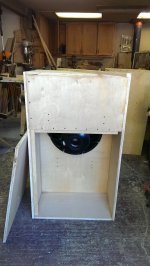I used the scrap birch to make 2 2in strips ran across the front and back. This made the front of the cab flush with the floor and appear seamless. From the side it gives you the perfect slot and height to slide in a dolly without needing to tip the cab (actually convenient if it's already butted against the next cab)
From the OP:
Using Hornresp simulations at rated Xmax values, (and impedance minima) average level from 35-100 Hz, the Keystone has these output levels:
BC21SW152-4 131.6 dB, 92 volts, 3.4 ohms, 2489 watts
BC18SW115-4 130.1 dB, 76v, 3.43 ohms, 1683 watts
BC18TBW100-4 127.8 dB, 59v, 3.32 ohms, 1048 watts
How did you fit a 21" in there?
With the same box / compression?
I extended the depth of mine to 80cm to avoid too much compression, they sim something like 140dB! Never did any real world measurements though...
Does your cab walk at all with just wood strips?
Using only 2" wide strips forces all of the cabinets weight into a more specific area. The same reason snow tires are skinnier, they pizza cutter through the snow because the weight is not distributed over the wider tire. That's one reason sports cars will hydroplane so much faster.
Also, by going long ways with the face and back, the force will only be able to create a tipping motion. I am sure if they are placed on the sides going front to back it would still walk, because you essentially put it on skis, but there is no side to side energy only front and back.
Thanks for the reply Bjones. I understand your analogy there, just seems like the plywood would be slick especially on something like a basketball gym floor for a dance or such. Made a lot more progress today on the builds. I have one cabinet with most of the braces and the horn baffle section put together. Everything is tight with the tolerances and going together great. I will snap some more pics and post them tomorrow when I get back to the shop. Just wanted to let everyone know I used a track saw to cut all the panels to size and every piece came out perfect. The track saws are wonderful, safe, accurate, and portable. If you haven't had the chance to use one, try it, you won't be disappointed. I own the Makita version.
I have come along ways in last two nights of working on the cabinets. Both horn sections are done with all bracing. I took extra time making sure everything fit as tight as possible for each cabinet. I am going to run the wiring, mount the audio jack, button it up and install the last permanent side today. Then I guess I get to do some patching of screw holes and sanding of bondo...ugh!
Is there a best type and location to add some handles to this box to facilitate transport? Could I recess some of these in the back upper section, or do they remove too much material and cause sound/vibration issues?
http://www.amazon.com/Reliable-Hard...im_267_25?ie=UTF8&refRID=0T7TB3049T2JHVP4BE4W
Is there a best type and location to add some handles to this box to facilitate transport? Could I recess some of these in the back upper section, or do they remove too much material and cause sound/vibration issues?
http://www.amazon.com/Reliable-Hard...im_267_25?ie=UTF8&refRID=0T7TB3049T2JHVP4BE4W
The paddle handles with grips are generally vibration free. The back upper section would be an OK location.Is there a best type and location to add some handles to this box to facilitate transport? Could I recess some of these in the back upper section, or do they remove too much material and cause sound/vibration issues?
This is only true if the surface the sub is on is being physically deformed like dirt, grass, or snow.Using only 2" wide strips forces all of the cabinets weight into a more specific area. The same reason snow tires are skinnier, they pizza cutter through the snow because the weight is not distributed over the wider tire. That's one reason sports cars will hydroplane so much faster.
For any surface that is not being deformed (wood, concrete, linoleum, asphalt, etc) you're only dealing with coefficient of friction and normal force. i.e The only way to keep the walk down is to weigh down the cab or use a foot material that grips better like rubber. Contact area does not have an effect.
Are there any problems with the dimension of panel G from the plan in post #487?
I've made a template over the side of the cab and everything including braces lines up very nice except panel G which should be a little shy of 1/4" longer to line up nicely(I'm doing 90° cuts and compensate with more glue/silicone)
I would not consider this a big problem if it wasn't for the importance of this panel for the accuracy of the layout.
All other measuring points are spot on as well.
I've made a template over the side of the cab and everything including braces lines up very nice except panel G which should be a little shy of 1/4" longer to line up nicely(I'm doing 90° cuts and compensate with more glue/silicone)
I would not consider this a big problem if it wasn't for the importance of this panel for the accuracy of the layout.
All other measuring points are spot on as well.
Weatherstrip should not be needed.For sealing the front panel, is weatherstrip ok to use along with the tee nuts? And if so, what thickness is sufficient?
- Home
- Loudspeakers
- Subwoofers
- Keystone Sub Using 18, 15, & 12 Inch Speakers
![IMAG1447[1].jpg](/community/data/attachments/449/449563-d66d6c5bcc3a91c216e9c93a7040b98c.jpg)
